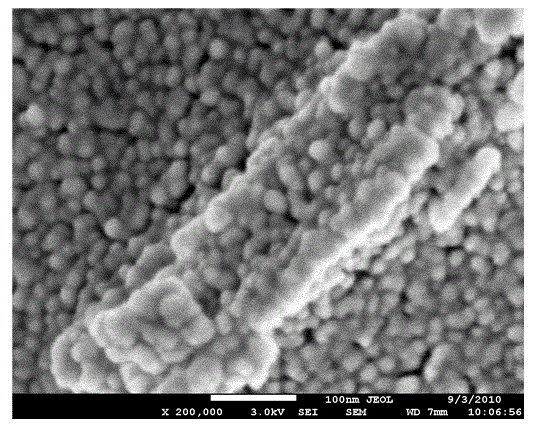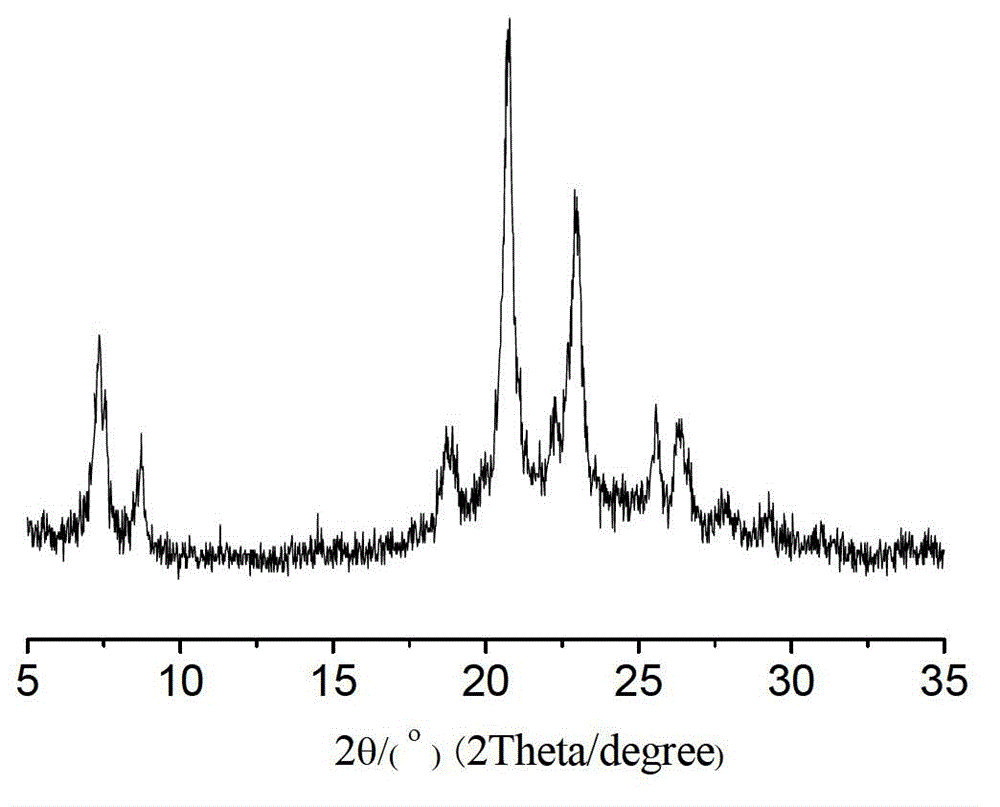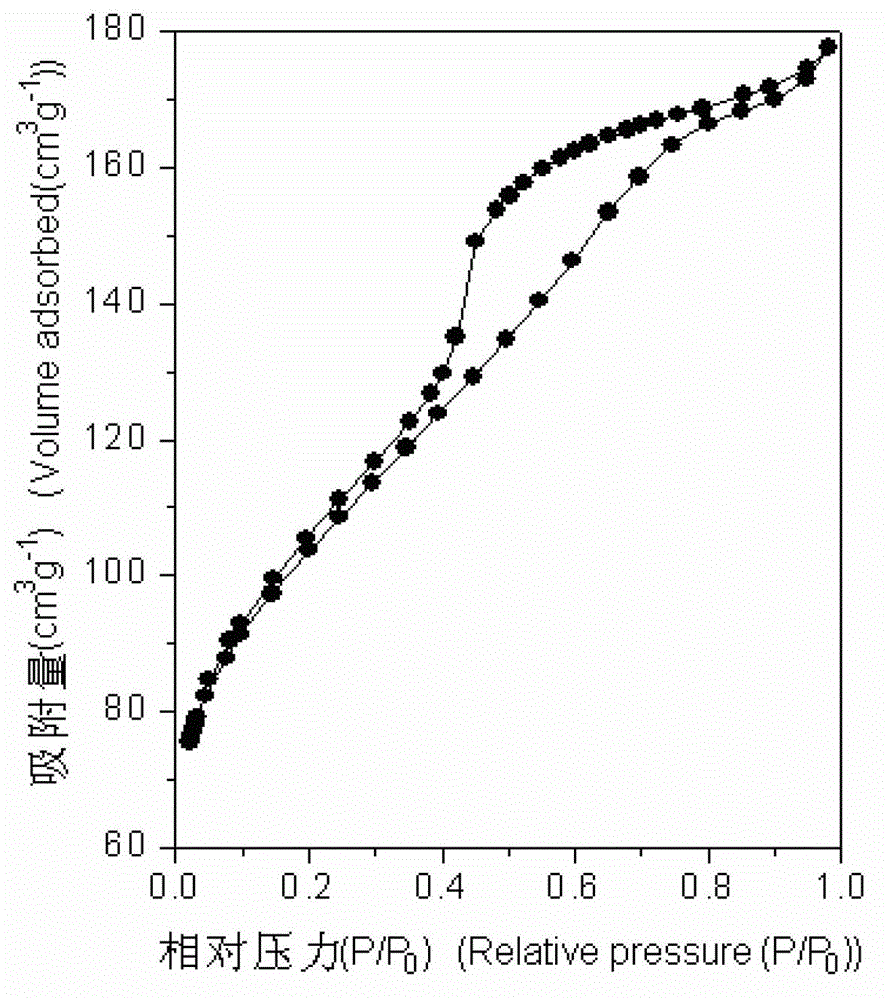Hierarchical pore zeolite molecular sieve preparation method
A technology of zeolite molecular sieve and multi-stage pores, which is applied in the direction of crystalline aluminosilicate zeolite, etc., to achieve the effect of improved diffusion path and low cost
- Summary
- Abstract
- Description
- Claims
- Application Information
AI Technical Summary
Problems solved by technology
Method used
Image
Examples
Embodiment approach 1
[0015] Step 1: At room temperature, mix 1.28g sodium metaaluminate, 1.89g sodium hydroxide, 18ml silica sol and 54ml distilled water to form a uniform white jelly, put it into a stainless steel reaction kettle, and conduct hydrothermal treatment at 170°C for 24 hours , then vacuum filtration, and retain the filtrate for subsequent use;
[0016] Step 2: Take 55ml of the above-mentioned filtrate, add 12.5g template agent tetraethylammonium bromide TEABr, 6ml ammonia water and 3ml silica sol to the filtrate, stir evenly, crystallize at 140 degrees Celsius for 7 days, then cool with tap water To room temperature, the product was washed with distilled water until neutral, filtered, dried in an oven at 100°C for 12 hours, and calcined in a muffle furnace at 550°C for 6 hours under the condition of ventilation to obtain the final sample. Analysis by XRD and SEM shows that the obtained sample is a ZSM-12 polycrystalline aggregate of about 10 microns in size composed of nano-sized grai...
Embodiment approach 2
[0018] Step 1: At room temperature, mix 1.28g sodium metaaluminate, 1.89g sodium hydroxide, 18ml silica sol and 54ml distilled water to form a uniform white jelly, put it into a stainless steel reaction kettle, and conduct hydrothermal treatment at 170°C for 24 hours , then vacuum filtration, and retain the filtrate for subsequent use;
[0019] The second step: take 50ml of the above-mentioned filtrate, add 10g template agent tetraethylammonium bromide TEABr, 5ml ammonia water and 15ml silica sol to the filtrate, stir evenly, crystallize at 170 degrees Celsius for 4 days, then cool with tap water to At room temperature, the product was washed with distilled water until neutral, filtered, dried in an oven at 100°C for 12 hours, and calcined in a muffle furnace at 550°C for 4 hours under air ventilation to obtain the final sample. Analysis by XRD and SEM shows that the obtained sample is a ZSM-12 polycrystalline aggregate of about 50 microns overall composed of nano-sized grains...
Embodiment approach 3
[0021] Step 1: At room temperature, mix 1.28g sodium metaaluminate, 1.89g sodium hydroxide, 18ml silica sol and 54ml distilled water to form a uniform white jelly, put it into a stainless steel reaction kettle, and conduct hydrothermal treatment at 170°C for 24 hours , then vacuum filtration, and retain the filtrate for subsequent use;
[0022] Step 2: Take 72ml of the above-mentioned filtrate, add 19.3g template agent tetraethylammonium bromide TEABr, 5ml ammonia water and 5ml silica sol to the filtrate, stir evenly, crystallize at 180 degrees Celsius for 5 days, then cool with tap water To room temperature, the product was washed with distilled water until neutral, filtered, dried in an oven at 100°C for 12 hours, and calcined in a muffle furnace at 550°C for 5 hours under air ventilation to obtain the final sample. The XRD characterization results show that the characteristic diffraction peaks of ZSM-12 are obviously broadened, see figure 1 , it is precisely because of th...
PUM
 Login to View More
Login to View More Abstract
Description
Claims
Application Information
 Login to View More
Login to View More - R&D
- Intellectual Property
- Life Sciences
- Materials
- Tech Scout
- Unparalleled Data Quality
- Higher Quality Content
- 60% Fewer Hallucinations
Browse by: Latest US Patents, China's latest patents, Technical Efficacy Thesaurus, Application Domain, Technology Topic, Popular Technical Reports.
© 2025 PatSnap. All rights reserved.Legal|Privacy policy|Modern Slavery Act Transparency Statement|Sitemap|About US| Contact US: help@patsnap.com



